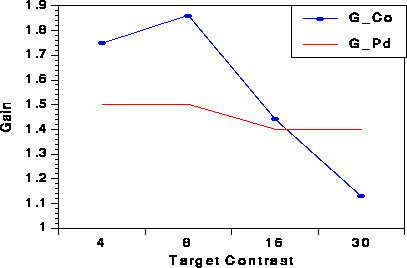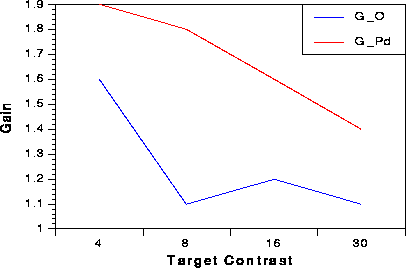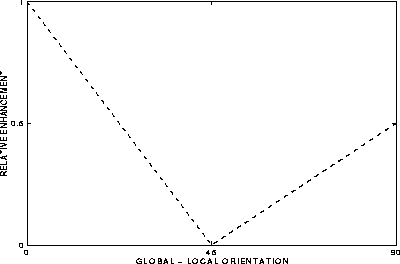


Next: Possible Mechanisms
Up: The Pattern and Functional
Previous: Neurophysiological Observations
The response gain as a function of contrast was measured in the VEP experiment and is described in figures 2 and 3. We measured the isolated target response and compared it to the measured target and
mask together. The results are described as amplitude gain, i.e. the measured target and mask response
divided by the isolated target response. The predicted gain response (the linear vector summation of target alone
and mask alone) is plotted also  . The gain was larger than the predicted gain (facilitation) for
collinear configuration (Figure 2) at 4-8% of contrast,
decreases with increasing contrast. At 30% contrast the measured gain was less than predicted.
The gain for the orthogonal configuration (Figure 3) was significantly less
than the prediction (suppression) for all contrasts. From 8% contrast and further there was no
significant gain.
For the collinear configuration, when facilitation was found
[29],
the measured phase was faster (lead) compared to the prediction while for the orthogonal
configuration the measured phase was significantly slower than the prediction (not shown here).
The low range of target contrast was slightly above the
observers' contrast thresholds for the Gabor target and therefore the VEP results were
obtained near the contrast detection regime measured in the psychophysical experiments.
Both studies found facilitation for collinear configurations but no effect for the
orthogonal configuration. However the VEP experiments extended to more suprathreshold target
contrasts and showed that the facilitation effect decreases with increasing contrast. Moreover,
the response for the high contrast mask was slightly smaller for the collinear
than the orthogonal configuration. Long-range facilitation may have made the effective
contrast of the collinear mask high enough to switch the effective interaction from
facilitation to inhibition.
. The gain was larger than the predicted gain (facilitation) for
collinear configuration (Figure 2) at 4-8% of contrast,
decreases with increasing contrast. At 30% contrast the measured gain was less than predicted.
The gain for the orthogonal configuration (Figure 3) was significantly less
than the prediction (suppression) for all contrasts. From 8% contrast and further there was no
significant gain.
For the collinear configuration, when facilitation was found
[29],
the measured phase was faster (lead) compared to the prediction while for the orthogonal
configuration the measured phase was significantly slower than the prediction (not shown here).
The low range of target contrast was slightly above the
observers' contrast thresholds for the Gabor target and therefore the VEP results were
obtained near the contrast detection regime measured in the psychophysical experiments.
Both studies found facilitation for collinear configurations but no effect for the
orthogonal configuration. However the VEP experiments extended to more suprathreshold target
contrasts and showed that the facilitation effect decreases with increasing contrast. Moreover,
the response for the high contrast mask was slightly smaller for the collinear
than the orthogonal configuration. Long-range facilitation may have made the effective
contrast of the collinear mask high enough to switch the effective interaction from
facilitation to inhibition.

Figure 2: VEP amplitude gain as a function of contrast in the collinear configuration.
Amplitude gain of the measured target and mask is computed relative to that of an isolated target
(G_Co). The predicted gain of target and
mask is also shown (G_Pd). The gain was larger than predicted for low contrasts but was smaller for
30% contrast. The test-mask distance was  or
or  .
.

Figure 3: Gain function as in Figure 2but for the orthogonal configuration (G_O).
VEP amplitude was less than predicted for all contrasts.
Facilitation magnitude and range are also a function of the offset between the Gabor target
orientation and the global orientation. The results depicted in Figure 4 show that maximal facilitation
is obtained when this offset is zero. A  offset yielded no enhancement, while with an orthogonal
offset, facilitation was found in the psychophysical experiments (
offset yielded no enhancement, while with an orthogonal
offset, facilitation was found in the psychophysical experiments ( ) but not in the VEP
(
) but not in the VEP
( ). This facilitation of sensitivity was independent of the global orientation.
Collinear configurations showed the largest long-range facilitation compared with the
other configurations
[31]. In the collinear configuration, long range facilitation can be increased with
practice
[32].
). This facilitation of sensitivity was independent of the global orientation.
Collinear configurations showed the largest long-range facilitation compared with the
other configurations
[31]. In the collinear configuration, long range facilitation can be increased with
practice
[32].

Figure 4: Effect of configuration and local orientation on visual threshold.
Three configurations in which the test and the flank targets shared the same local
orientation (vertical ( ), oblique (
), oblique ( ) or horizontal (
) or horizontal ( ) and the same global orientation
(vertical;
) and the same global orientation
(vertical;  ). A collinear configuration occurred for
). A collinear configuration occurred for  local orientation. The data
are maximal facilitation averaged from 3 subjects. Similar results were obtained in
VEP experiments (not shown here
[29]) for 6 observers and a test-to-flank
separation of 6 wavelengths (
local orientation. The data
are maximal facilitation averaged from 3 subjects. Similar results were obtained in
VEP experiments (not shown here
[29]) for 6 observers and a test-to-flank
separation of 6 wavelengths ( ).
).



Next: Possible Mechanisms
Up: The Pattern and Functional
Previous: Neurophysiological Observations
 . The gain was larger than the predicted gain (facilitation) for
collinear configuration (Figure 2) at 4-8% of contrast,
decreases with increasing contrast. At 30% contrast the measured gain was less than predicted.
The gain for the orthogonal configuration (Figure 3) was significantly less
than the prediction (suppression) for all contrasts. From 8% contrast and further there was no
significant gain.
For the collinear configuration, when facilitation was found
[29],
the measured phase was faster (lead) compared to the prediction while for the orthogonal
configuration the measured phase was significantly slower than the prediction (not shown here).
The low range of target contrast was slightly above the
observers' contrast thresholds for the Gabor target and therefore the VEP results were
obtained near the contrast detection regime measured in the psychophysical experiments.
Both studies found facilitation for collinear configurations but no effect for the
orthogonal configuration. However the VEP experiments extended to more suprathreshold target
contrasts and showed that the facilitation effect decreases with increasing contrast. Moreover,
the response for the high contrast mask was slightly smaller for the collinear
than the orthogonal configuration. Long-range facilitation may have made the effective
contrast of the collinear mask high enough to switch the effective interaction from
facilitation to inhibition.
. The gain was larger than the predicted gain (facilitation) for
collinear configuration (Figure 2) at 4-8% of contrast,
decreases with increasing contrast. At 30% contrast the measured gain was less than predicted.
The gain for the orthogonal configuration (Figure 3) was significantly less
than the prediction (suppression) for all contrasts. From 8% contrast and further there was no
significant gain.
For the collinear configuration, when facilitation was found
[29],
the measured phase was faster (lead) compared to the prediction while for the orthogonal
configuration the measured phase was significantly slower than the prediction (not shown here).
The low range of target contrast was slightly above the
observers' contrast thresholds for the Gabor target and therefore the VEP results were
obtained near the contrast detection regime measured in the psychophysical experiments.
Both studies found facilitation for collinear configurations but no effect for the
orthogonal configuration. However the VEP experiments extended to more suprathreshold target
contrasts and showed that the facilitation effect decreases with increasing contrast. Moreover,
the response for the high contrast mask was slightly smaller for the collinear
than the orthogonal configuration. Long-range facilitation may have made the effective
contrast of the collinear mask high enough to switch the effective interaction from
facilitation to inhibition.




 or
or  .
.
 offset yielded no enhancement, while with an orthogonal
offset, facilitation was found in the psychophysical experiments (
offset yielded no enhancement, while with an orthogonal
offset, facilitation was found in the psychophysical experiments ( ) but not in the VEP
(
) but not in the VEP
( ). This facilitation of sensitivity was independent of the global orientation.
Collinear configurations showed the largest long-range facilitation compared with the
other configurations
[
). This facilitation of sensitivity was independent of the global orientation.
Collinear configurations showed the largest long-range facilitation compared with the
other configurations
[
 ), oblique (
), oblique ( ) or horizontal (
) or horizontal ( ) and the same global orientation
(vertical;
) and the same global orientation
(vertical;  ). A collinear configuration occurred for
). A collinear configuration occurred for  local orientation. The data
are maximal facilitation averaged from 3 subjects. Similar results were obtained in
VEP experiments (not shown here
[
local orientation. The data
are maximal facilitation averaged from 3 subjects. Similar results were obtained in
VEP experiments (not shown here
[ ).
).